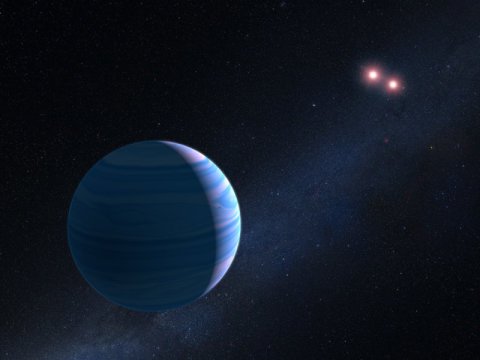Astronomers using the Hubble Space Telescope and a trick of nature have confirmed the existence of a planet orbiting two stars in the OGLE-2007-BLG-349 system, located 8,000 light-years away toward the center of our galaxy. The observations are the first in which a three-body system has been discovered using the micro-cleaning technique

Astronomers using the Hubble Space Telescope, as well as a trick of nature, have confirmed the existence of a planet orbiting two stars in the OGLE-2007-BLG-349 system, located 8,000 light-years away toward the center of our galaxy.
The planet orbits in an orbit of about 300 million kilometers - roughly the distance from the Sun to the asteroid belt in our solar system - the pair of stars. The planet completes its orbit around the two stars approximately every seven years. The two red dwarfs are only 7 million kilometers apart, or 14 times the diameter of the Moon's orbit around Earth.
The Hubble observations are the first time that such a system has been confirmed using the micro-sanding technique. The phenomenon of gravitational obsolescence occurs when the gravitational force of a star that is on the way to the target star, increases the light of the star that is in the background as they align with each other relative to us. Increasing the light can reveal clues about the nature of the star and its planets.
The three objects were discovered in 2007 through an international collaboration of five different groups using ground-based telescopes:
Microlensing Observations in Astrophysics (MOA), the Optical Gravitational Lensing Experiment (OGLE), the Microlensing Follow-up Network (MicroFUN), the Probing Lensing Anomalies Network (PLANET), and the Robonet Collaboration. These observations revealed a star, a planet and a third body whose nature has not been identified.
"The ground-based observations suggested two possible scenarios for the triple system: a Saturn-mass planet orbiting a pair of stars, or a Saturn-mass planet and another Earth-mass planet orbiting a single star. explained David Bennett of NASA's Goddard Space Flight Center in Greenbelt, Maryland, the paper's first author.
The sharpness of Hubble's images allowed the research team to separate the source star in the background and the lensing star from their neighbors by a very tight margin. Hubble's observations revealed that the stars observed in front of the lens were too faint to be a single star, but the brightness is similar to what would be expected if they were two red dwarfs orbiting each other closely, and they are known to be much, much fainter and less massive than our Sun. "Therefore, the model of one planet orbiting two red dwarfs is the only one consistent with the Hubble data," Bennett said.
Bennett's team won follow-up observations with Hubble's Wide Field Camera 2. "We were aided in the analysis by almost perfect alignment of the foreground double star with the star in the background, which increased the light greatly and allowed us to see the signal from both stars," Bennett explained. .
The Kepler space telescope has discovered ten other planets orbiting double stars but are much closer to one of the stars than the new planet is to both stars combined. Now that the team has shown that micro-implantation can be a successful method for discovering planets orbiting binary systems, Hubble could play an important role in this new field in the ongoing search for planets outside the solar system.
to the notice of the researchers
More of the topic in Hayadan:
Is there life on the nearest planet Proxima Centauri b
Three planets with potential for life orbit a cold red dwarf close to the solar system
Almost every red dwarf has planets

One response
It is important to note that this is a system that existed 8000 years ago.
Because their light took 8000 years to get here.